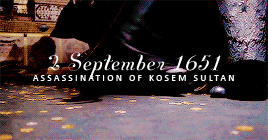ottomanladies:On this day in Ottoman history, Kösem Valide Sultan was assassinated:On the night of 2
ottomanladies:On this day in Ottoman history, Kösem Valide Sultan was assassinated:On the night of 2 September 1651 the palace gates had been left open on Kösem’s orders to let her men inside but instead it was Turhan’s faction who acted: the Chief Black Eunuch Süleyman Ağa led the halberdiers with tresses and the pages of the Privy Chambers to Kösem’s apartments. “Hearing the commotion, Kösem thought the Janissary officers had arrived and called out, ‘Have they come?’ 'Yes, they have come,’ Süleyman Ağa answered. ‘Only come out.’" Kösem recognised the voice and fled from her bedroom through the Golden Way and the Court of the Black Eunuchs to the Dome with Closets, “probably hoping to get out through the Carriage Gate”. The gate had been closed, though, so the elderly woman had to hide in one of the closets inside that room.Süleyman Ağa ran after her with his men and a slave concubine tried to save Kösem - or at least buy her some time - by stopping them and yelling “I am the valide sultan!” but it was useless, the Chief Black Eunuch knew she was not and thrust her aside. Arrived to the last room before the Carriage Gate, they started to open all the closets until they found the old valide sultan and dragged her out. Kösem threw gold coins on the floor as a distraction but one of the men did not fell for it and held her down. An Albanian called Ali Bostanci, tore her earrings away: “[t]hey were two Diamonds of the bigness of Chestnuts cut angularly, and beneath each Diamond was a Ruby to set it off. Those ear-rings were given her by Sultan Ashmet in the time of the most flourishing Age, and his greatest affection. […] Others also plucked her, some by the hands, others by the feet, some rifled her Cloaths, for she was furnished throughout with things of great value sewed in her Garments, and especially in her Sable Furs. […] The Person who gave me this relation, informed me, that he had seen a certain lock admirably made, and engraved with the Names of Murad and Sultan Ibrahim”, told Paul Rycaut.It is not clear how Kösem Sultan was strangled: some sources say with her own hair, others with the cord of a curtain; all agree, though, that the old valide sultan fought for her life and that she survived the first strangling.“The death of this powerful, widely respected, and widely feared woman provoked a political crisis. When news of the valide sultan’s violent death became public, the people of Istanbul shut down the city’s mosques and markets for three days in mourning. Kösem’s murder precipitated a series of reprisals. The first phase was the execution of Kösem’s Janissary allies and the elimination of the faction they had led, which had controlled government during the three years of Kösem’s regency to Mehmed. In the second phase, popular anger at this purge led to pressure on the new palace regime under Turhan to dismiss the grand vezir, who had carried out the executions.”Kösem Sultan was buried in the mausoleum of Ahmed I, where she rests between him and her eldest daughter Ayşe. The inscription on her tomb is telling of the heights she had reached during her life: “Valide-i Mu’azzama, Koca-Valide, Ümmü’l-Mü’minin, Valide-i Atika, Valide-i Kebire, Büyük-Valide, Sahıbetü’l-Makaam”sources: Fanny Davis - The Palace of Topkapi in Istanbul, Leslie P. Peirce -The Imperial Harem: Women and Sovereignty in the Ottoman Empire, Paul Rycaut - The present state of the Ottoman Empire, Necdet Sakaoğlu - Bu Mülkün Kadın Sultanları -- source link
Tumblr Blog : ottomanladies.tumblr.com
#history ottoman#type gif#user connie







